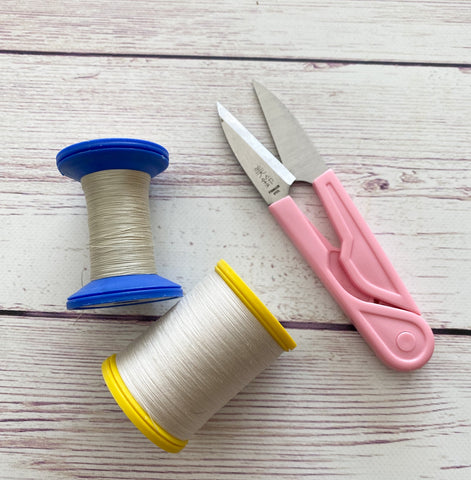
A round-up of my hand sewing essentials for a more satisfying stitching experience
Have you ever wanted to try your hand at sewing but didn't know where to start? Hand sewing is a great way to get started in the world of sewing, and all you need are a few basic tools. In this blog post, I will run through the essential hand-sewing tools that every beginner should have in their sewing kit. Whether you're looking to repair clothing, stitch a sample, or just enjoy the satisfaction of making something by hand, they will help you get started on your sewing journey. So, let's dive in and explore some of my favourites!
Needles & Pins
For hand piecing, EPP and applique you will be spending a lot of time with the needle in your hand so comfort is key. The needles most commonly used by quilters are the short and manoeuvrable Sharps and the longer Milliners which allow you to load more stitches. Both have a fine shaft and small eye which means they glide smoothly through the layers of cloth with minimal resistance. My favourites are Bohin and Foxglove Cottage brands. You can read more about hand-sewing needles in a more detailed blog post here.
When it comes to pinning, I like to use glass head pins. They are easier to see and grab and these Sohmo brand pins come in a handy tin.
For applique, I like the small Clover applique pins. They are short which is great for small pieces and have a teardrop-shaped head which is less likely to get caught in the thread as I stitch.
Threads
When it comes to hand sewing, choosing the right thread is just as important as using the right needles.
For needleturn applique and English Paper Piecing, I like to use Bottom Line thread. This polyester thread is a great choice because it is super fine making your stitches almost invisible, but also really strong.
For hand piecing, I like to use Cotton + Steel 50-wt thread. It is made from long-staple Egyptian cotton and is top-notch. 50-wt cotton thread is ideal because it is strong enough to withstand the wear and tear of everyday use, and creates a smooth even seam. It also comes in some pretty delicious shades, though my go-to colours are neutrals like the creamy-yet-murky Greige and Grey Khaki.
Whenever preparing patchwork pieces using templates, I use a sandpaper board underneath to prevent slipping and ensure more accurate markings. To measure the seam allowance I grab my Handy Little Ruler to mark my stitching lines.

Thimbles
If you stitch for any length of time you will need a thimble to protect the finger you use to push the needle through the layers of fabric. I have tried a lot of brands over the years and find the Clover Protect and Grip thimbles to be the most comfortable. Made of silicone it has a cushion-like feel and the needle doesn't slip on the metal tip.
I do swap to a rigid nickle thimble for hand quilting as as I need that extra bit of sturdiness for the rocking stitch method I use. (That's probably a whole new blog post!)

Thread Conditioner
Thread Balm strengthens and lubricates your thread, reducing friction and preventing tangling. It leads to stronger and more durable stitching, enhancing the quality of your sewing projects. My Thread Balm is the original and the best Australian-made thread conditioner. It is made from locally sourced beeswax to my specifications so that it coats the thread smoothly and doesn't leave a tacky or flaky residue like some of the others on the market. I know it is hard to imagine if you haven't tried it, but it really does make a difference.
You can find a more detailed blog post about Thread Balm here
Investing in high-quality sewing tools can make all the difference when it comes to enjoying the stitching process. Not only do they make the work easier and more efficient, but they also produce better results. Happy stitching!








Leave a comment